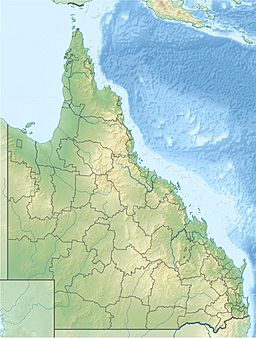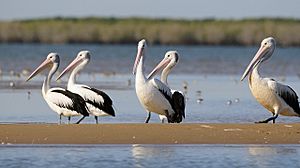Lake Yamma Yamma facts for kids
Quick facts for kids Lake Yamma Yamma |
|
|---|---|
| Location | Channel Country, Queensland |
| Coordinates | 26°16′40″S 141°27′31″E / 26.27778°S 141.45861°E |
| Primary inflows | Yamma Creek, Cooper Creek |
| Basin countries | Australia |
| Surface area | 69,000 ha (690 km2; 270 sq mi) |
Lake Yamma Yamma is a special kind of lake in Queensland, Australia. It's called an ephemeral lake, which means it doesn't always have water. It's found in a dry area called the Channel Country, near a river system called Cooper Creek.
Sometimes people call it Lake Mackillop. It's the biggest lake of its kind in Queensland that isn't connected to the ocean.
About Lake Yamma Yamma
This lake only fills up when there are big floods from Cooper Creek. When it's full, the lake is huge! It covers about 69,000 hectares, which is like 690 square kilometers. That's a really big area!
It only gets completely full about once every 25 to 30 years. The last time it was full was in the year 2000.
Right after it fills, the water is fresh. But as the lake starts to dry up, the water gets saltier.
When the lake is dry, the ground is made of cracked grey clay. This clay supports wide areas of grasslands. A common grass found here is called rat's tail couch. After some rain or small floods, other small plants also grow among the grass.
In the north-eastern part of the lake, you can find open areas with lignum shrubs. There are also patches of open woodland with coolabah trees and belalie trees.
Amazing Birds of the Lake
Lake Yamma Yamma is a very important place for birds. BirdLife International has named it an Important Bird Area (IBA). This means it's a key spot for many bird species. The lake and its nearby areas, including the Barrolka Lakes, cover about 1,218 square kilometers.
Many different birds come here. For example, over 1% of the world's population of plumed whistling-ducks, sharp-tailed sandpipers, and Australian pelicans have been seen here. It's also a home for Australian bustards.
A very large group of Australian pelicans makes their nests and raises their young on an island at the north-eastern end of the lake. The Barrolka Lakes also have several colonies of cormorants.
Other birds that visit in large numbers include hardheads, white-headed stilts, glossy ibises, grey teals, black-tailed nativehens, Australian pratincoles, whiskered terns, and Pacific black ducks. You might also spot smaller numbers of freckled ducks and white-winged black terns.



